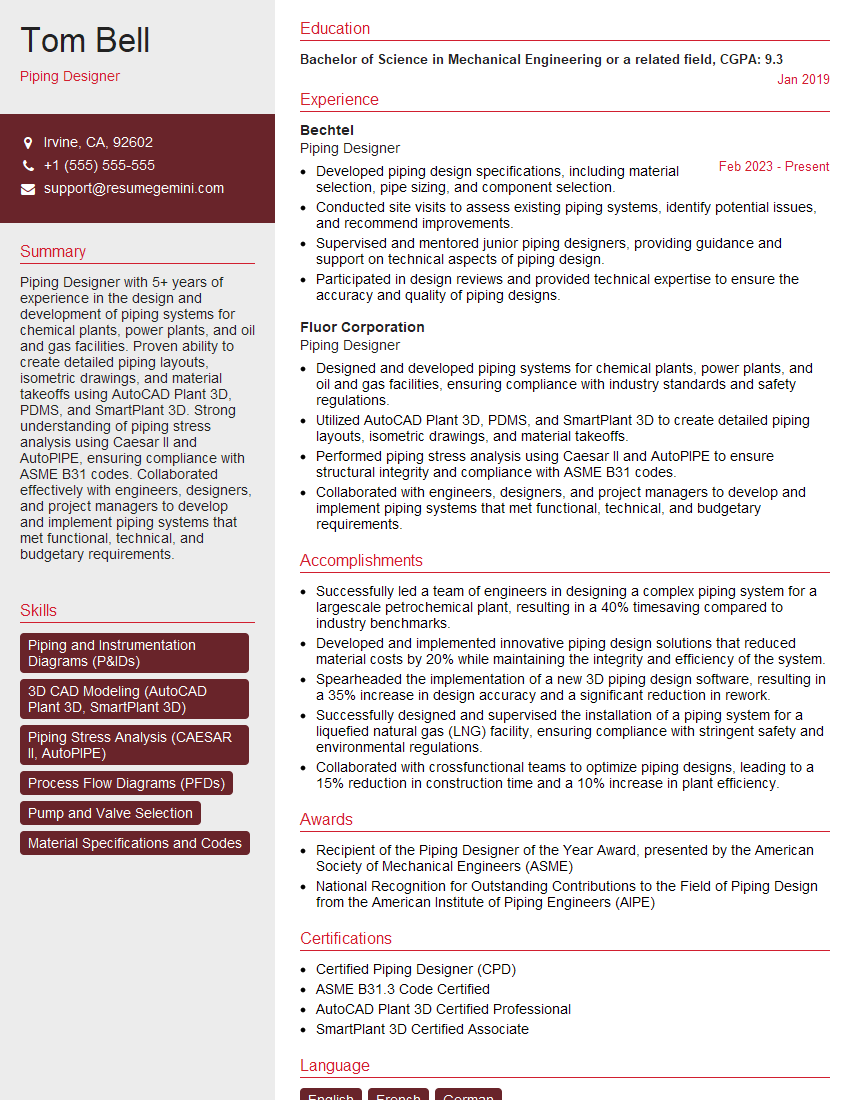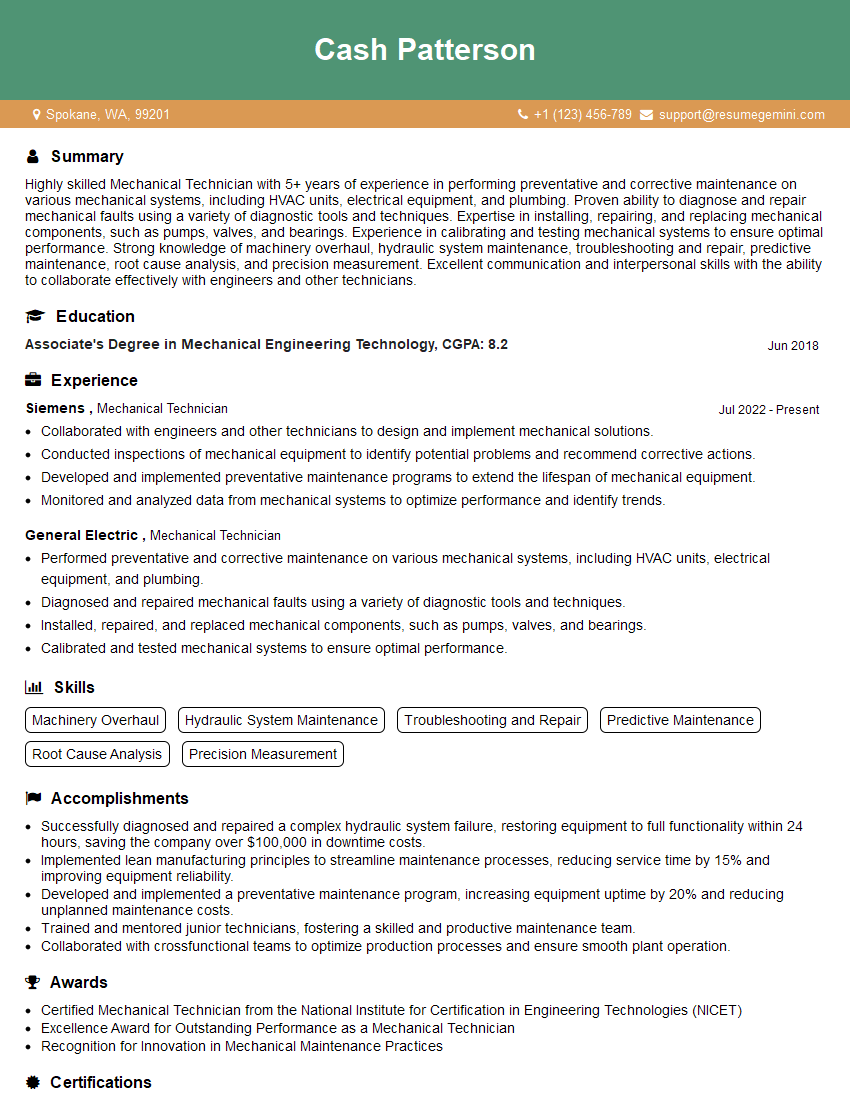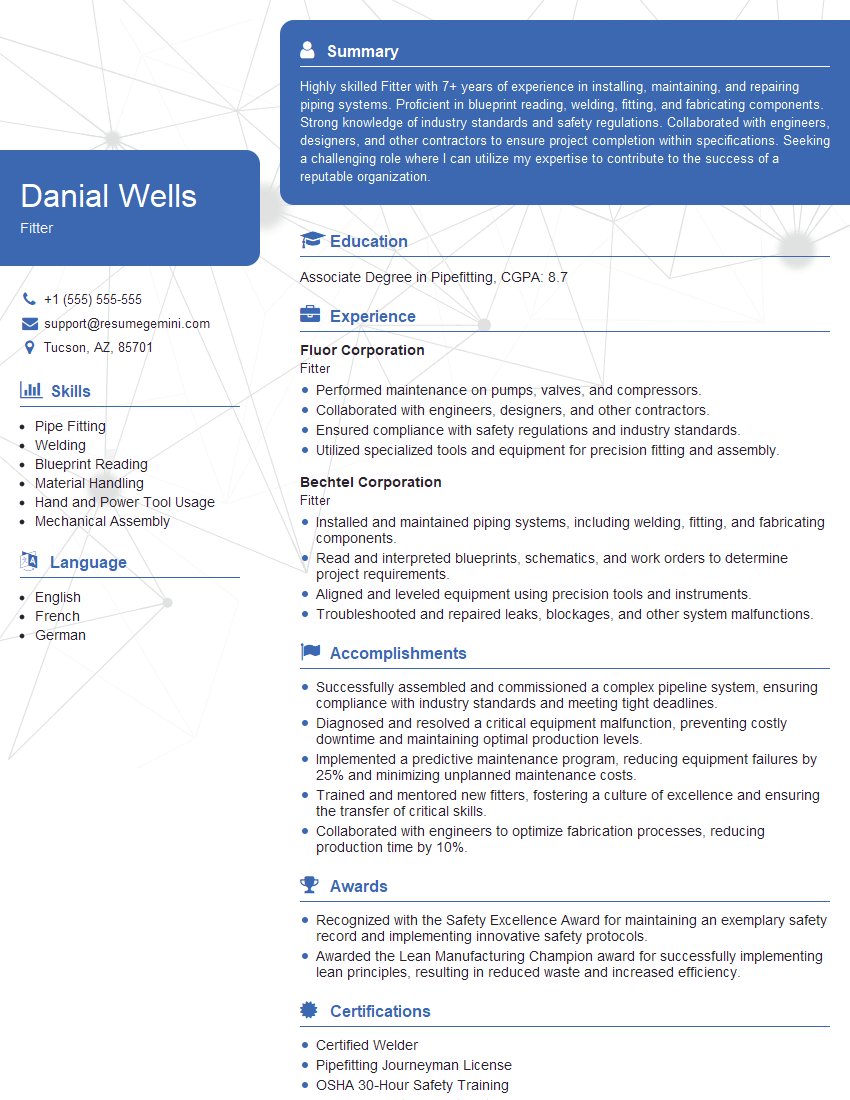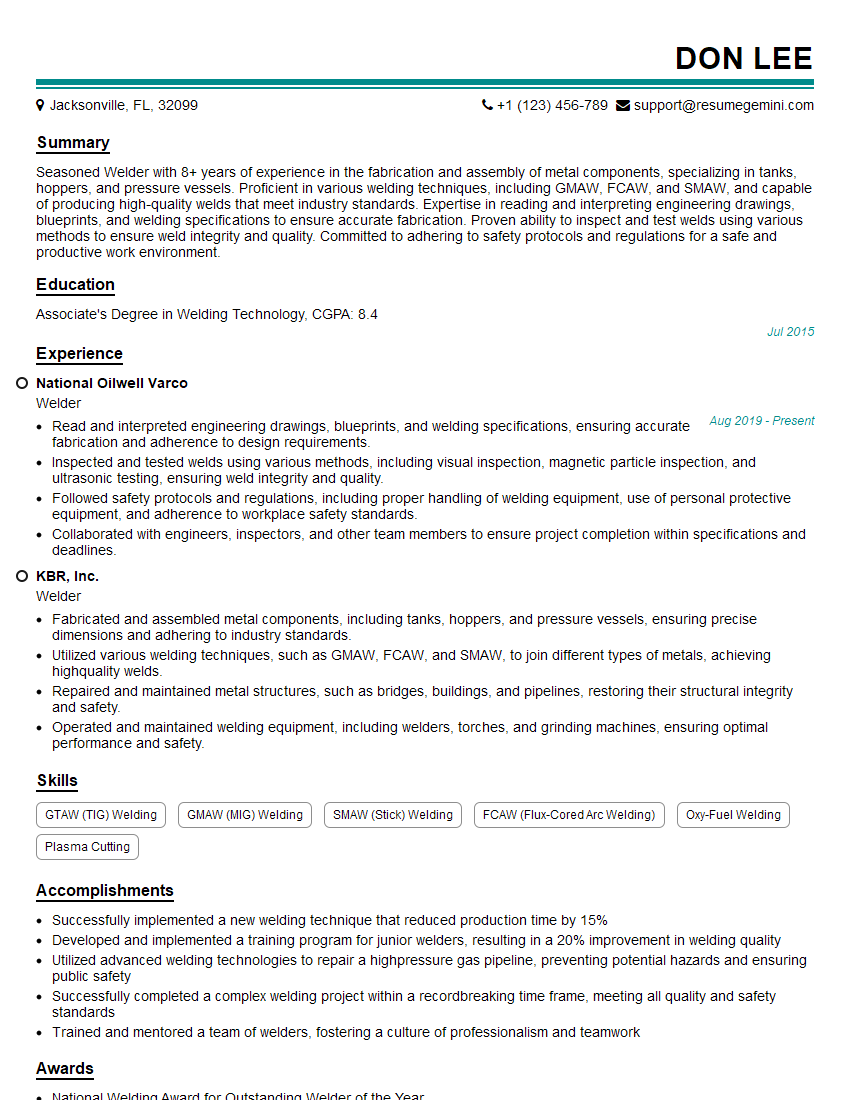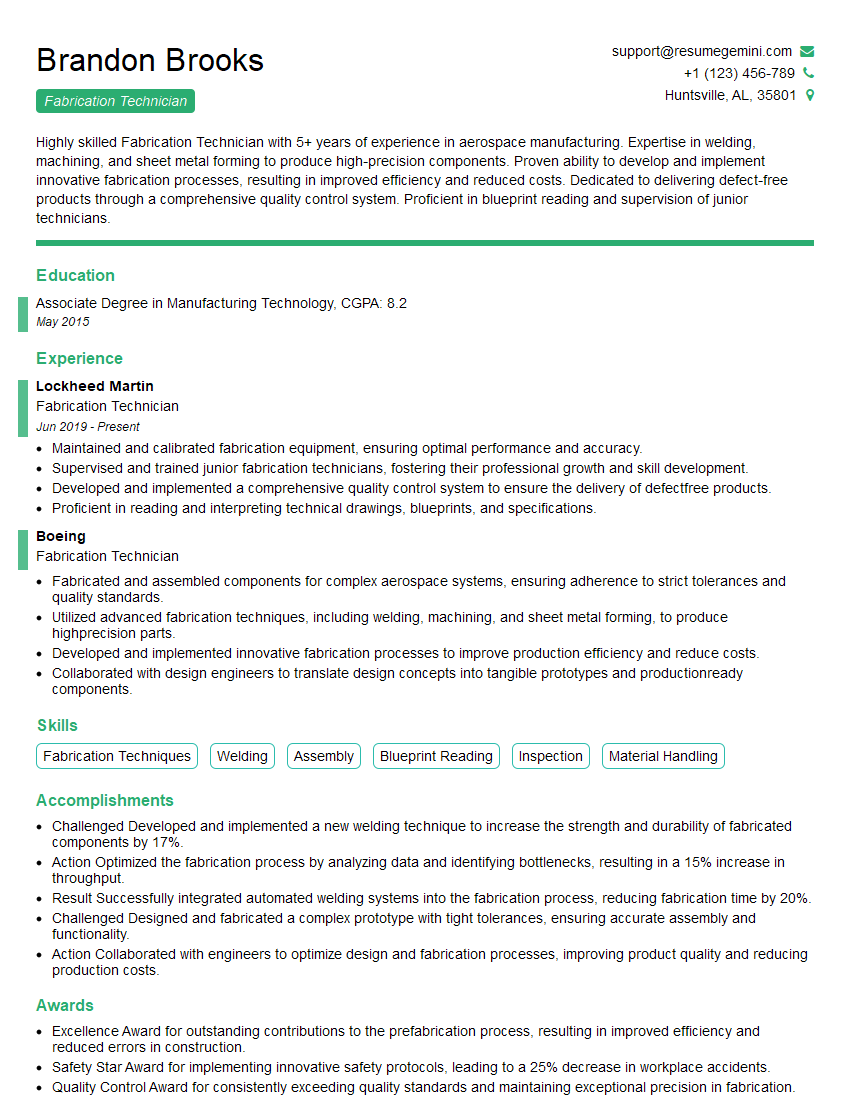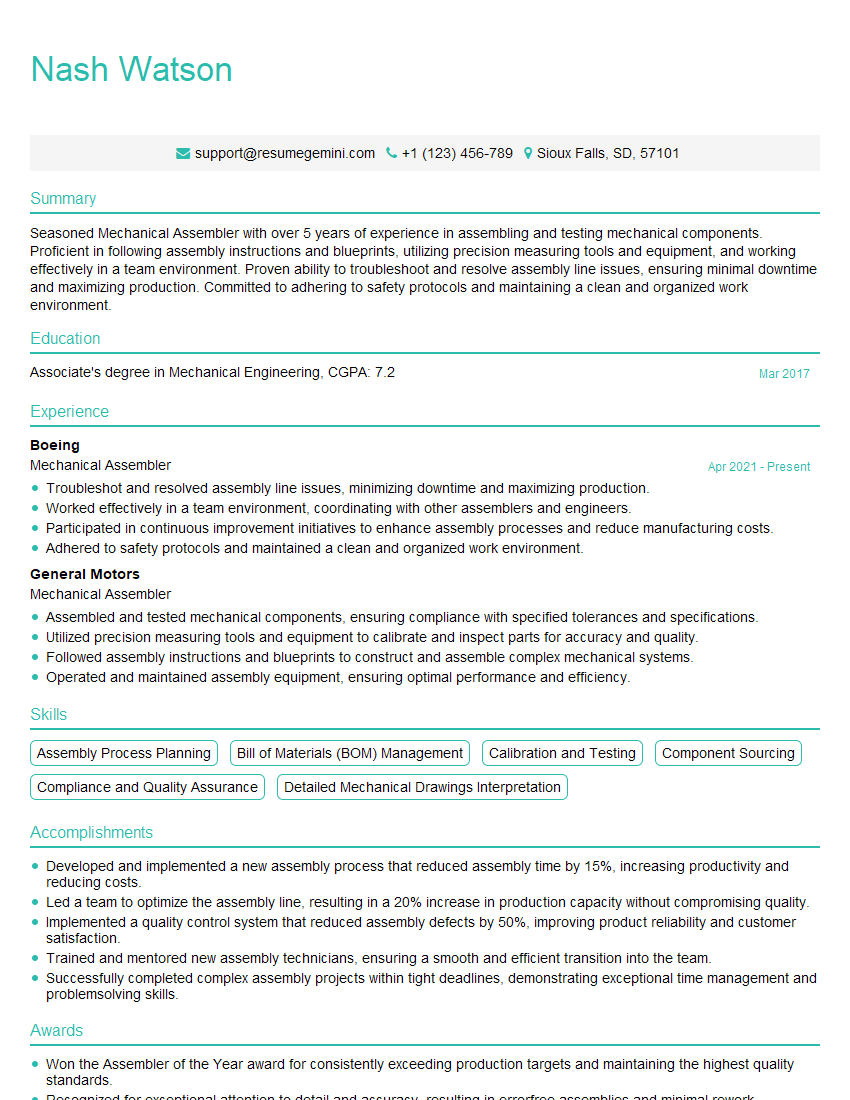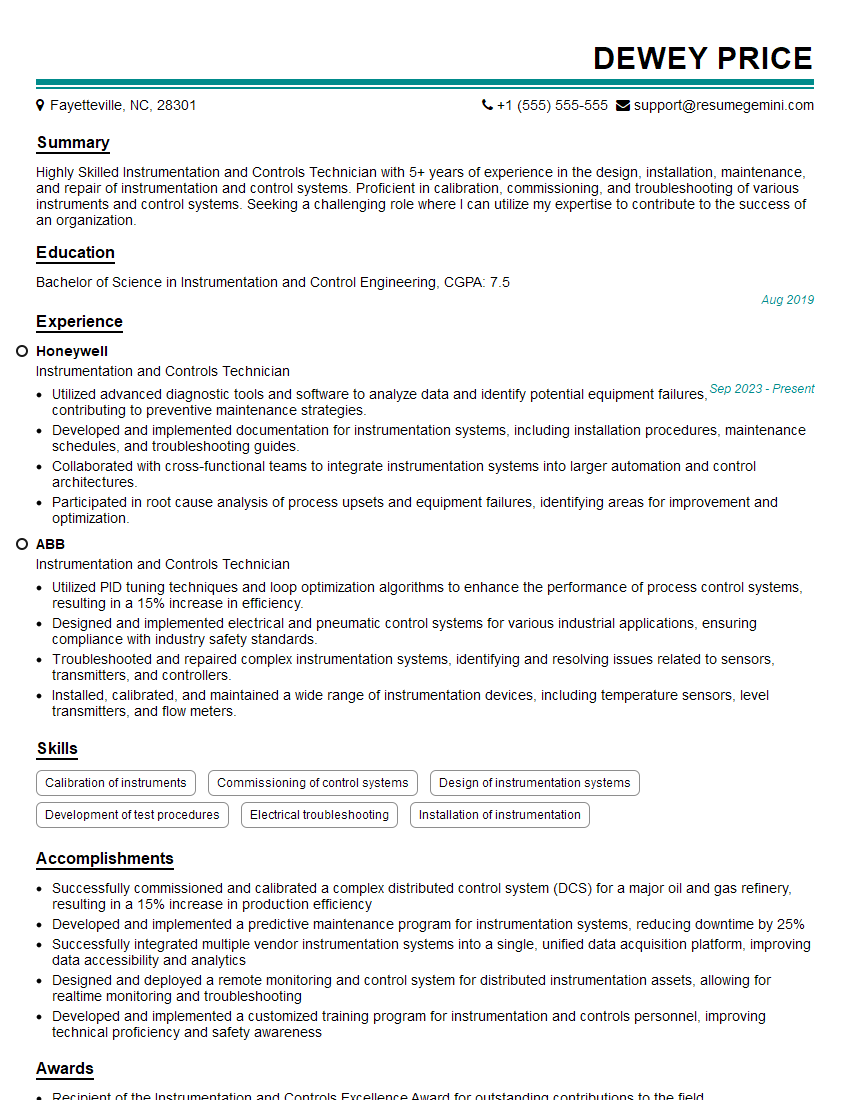Interviews are opportunities to demonstrate your expertise, and this guide is here to help you shine. Explore the essential Piping and Mechanical Assembly interview questions that employers frequently ask, paired with strategies for crafting responses that set you apart from the competition.
Questions Asked in Piping and Mechanical Assembly Interview
Q 1. Explain the different types of pipe fittings and their applications.
Pipe fittings are crucial components that connect pipes, change direction, or modify flow characteristics. They come in various types, each suited for specific applications. Think of them as the connectors and adapters in a plumbing system.
- Elbows: Change the direction of the pipe flow. 45-degree and 90-degree elbows are common. Imagine a road turning; the elbow directs the flow like a turn in the road.
- Tees: Allow for branching connections, splitting flow in three directions. Think of a traffic intersection where roads meet.
- Crosses: Provide four-way connections. These are like four-way intersections in a highway system.
- Reducers/Enlargers: Change the pipe diameter, adapting to different flow requirements. This is like adjusting the size of a pipe to handle different amounts of water flow.
- Couplings: Connect two pipes of the same diameter. This is a simple connection, like joining two sections of track together.
- Unions: Allow for easy pipe disassembly. They’re like a screw-on coupling, useful for maintenance or repairs.
- Caps: Seal the end of a pipe, like a plug sealing a container.
- Flanges: Provide a bolted connection for large diameter or high-pressure pipes, offering a robust and easily removable connection.
- Valves: Control the flow of fluids; including gate valves, globe valves, ball valves, and check valves, each designed for specific flow regulation needs.
The choice of fitting depends on factors like pipe material, pressure, temperature, fluid type, and the overall system design. For instance, a high-pressure steam line would require strong flanged connections and heavy-duty valves, while a low-pressure water line might utilize simpler fittings like threaded couplings.
Q 2. Describe your experience with various pipe materials (e.g., steel, PVC, copper).
My experience encompasses a wide range of pipe materials, each with its own properties and applications. The selection of material is critical for system performance and longevity.
- Steel: A workhorse material, offering high strength and durability. Used extensively in high-pressure applications and where corrosion resistance might require additional coatings or galvanization. I’ve worked with carbon steel, stainless steel (various grades like 304 and 316 for corrosive environments), and even cast iron in legacy systems. Each choice affects welding and installation techniques.
- PVC (Polyvinyl Chloride): A versatile and cost-effective option for low-pressure applications like drainage and water supply systems. Its lightweight nature makes installation easier, but it has lower temperature and pressure limits than steel. I have extensive experience joining PVC pipes using solvent welding.
- Copper: Excellent corrosion resistance makes it suitable for potable water systems and applications where chemical compatibility is critical. Copper’s ductility allows for bending and shaping, which is useful in complex installations. However, it’s more expensive than steel or PVC and can require specialized joining techniques such as brazing or soldering.
My experience includes evaluating material properties, considering factors like corrosion resistance, thermal expansion, and cost to select the optimal material for specific projects. For example, I once chose stainless steel for a pharmaceutical piping system due to its hygienic properties and resistance to chemicals used in the production process.
Q 3. How do you ensure proper alignment during piping assembly?
Proper alignment is paramount in piping assembly; misalignment leads to stress concentrations, leaks, and premature component failure. It’s like building a strong bridge – every component must be correctly aligned for structural integrity.
Ensuring alignment involves a multi-step approach:
- Careful Planning: Begin with detailed isometric drawings and accurate measurements. This stage is crucial to minimize errors during installation.
- Accurate Pipe Cutting and Preparation: Precise cutting avoids misalignment from the start. Beveling edges properly is also critical for quality welding.
- Appropriate Supports and Guides: Temporary supports and guides ensure that pipes are in place during welding or joining operations, preventing shifting or sagging.
- Laser Alignment Tools: Advanced tools like laser alignment systems help check the alignment of pipes and fittings with extreme accuracy.
- Manual Checks: Even with modern tools, frequent visual checks and plumb bobs are vital, ensuring that the pipe runs are level and aligned.
- Iterative Adjustments: Minor adjustments are often necessary, so the process requires iterative checks and corrections.
In practice, neglecting proper alignment can lead to costly repairs or replacements. I’ve seen projects where improper alignment resulted in pipe stresses that caused leaks or even pipe failures, leading to significant downtime and expenses. Using appropriate tools and techniques, combined with careful planning and attention to detail, minimizes these risks.
Q 4. What are the common methods for pipe support and their selection criteria?
Pipe support is essential for preventing stress, vibration, and sagging, ensuring the system’s longevity and safety. It’s akin to the foundation of a building; a poorly supported structure will eventually fail.
Common methods include:
- Hangers: Support pipes from above, often used for vertical runs. Selection depends on pipe weight, material, and anticipated movement.
- Supports: Provide lateral and vertical support. Examples include pipe rests, cradles, and shoes. These support pipes from below or the sides.
- Anchors: Rigidly fix pipes to prevent movement from thermal expansion or other forces. Often located near bends and valves.
- Guides: Restrict pipe movement in one direction, commonly used to prevent excessive lateral movement from vibrations.
The selection criteria are based on several factors:
- Pipe Size and Weight: Larger and heavier pipes require more robust support systems.
- Operating Temperature and Pressure: Higher temperatures and pressures increase thermal expansion and stress, necessitating more careful support design.
- Fluid Type: The characteristics of the fluid (density, corrosiveness) might dictate support material choices.
- Environmental Factors: External factors like wind loads or seismic activity must be accounted for.
- Vibration Levels: Vibration isolation may be required in some applications.
Incorrect support selection can lead to costly repairs and potential safety hazards. For example, I once encountered a system with insufficient pipe supports that resulted in pipe sagging, causing stress cracks and eventual leaks.
Q 5. Explain your understanding of piping stress analysis.
Piping stress analysis is a crucial aspect of piping design that assesses the stresses and strains on pipe systems due to various factors like pressure, temperature, weight, and external forces. It’s like structural analysis for buildings, but applied to piping systems.
It involves using software tools and engineering principles to predict the behavior of the pipe system under different operating conditions. This includes:
- Static Analysis: Assessing stresses under steady-state conditions, such as internal pressure.
- Dynamic Analysis: Evaluating stresses due to time-varying loads like pressure surges or vibrations.
- Thermal Analysis: Considering the effects of temperature changes on pipe expansion and contraction.
- Seismic Analysis: Determining the response of the system to earthquakes.
The results of stress analysis are used to determine:
- Adequacy of Supports: Identifying potential areas of high stress and ensuring sufficient support is provided.
- Pipe Wall Thickness: Verifying that the pipe wall thickness is sufficient to withstand the calculated stresses.
- Component Selection: Ensuring that fittings and valves are capable of handling the anticipated loads.
Ignoring stress analysis can lead to failures that result in significant safety risks and economic losses. I’ve seen instances where inadequate stress analysis resulted in pipe failures, causing costly downtime and potential environmental damage.
Q 6. Describe your experience with different types of pipe welding techniques.
My experience spans various pipe welding techniques, each chosen based on the pipe material, diameter, and application requirements.
- Shielded Metal Arc Welding (SMAW): A versatile process suitable for various pipe materials, utilizing a coated electrode to protect the weld from atmospheric contamination. It’s robust but can be slower than other techniques.
- Gas Metal Arc Welding (GMAW): Commonly known as MIG welding, it utilizes a continuous wire electrode and shielding gas to produce high-quality welds. It is faster than SMAW and well-suited for automated applications.
- Gas Tungsten Arc Welding (GTAW): Also known as TIG welding, it employs a non-consumable tungsten electrode and is ideal for producing high-quality welds in thin-walled pipes and materials requiring precise control.
- Flux-Cored Arc Welding (FCAW): This process uses a tubular electrode containing flux, eliminating the need for a separate shielding gas. It’s often used for outdoor applications where wind might affect shielding gas.
The selection of the welding technique also depends on the specific requirements of the project, such as the need for high-quality welds in critical applications or the preference for speed in large-scale projects. For instance, I used GTAW for welding stainless steel pipes in a food processing plant to ensure hygienic, high-quality welds. While for a larger carbon steel pipeline, GMAW offered better speed and efficiency.
Q 7. How do you ensure the quality and integrity of welded joints?
Ensuring the quality and integrity of welded joints is critical for the safety and reliability of any piping system. It is like ensuring the structural integrity of a bridge – a weakness in one joint could compromise the entire structure.
My approach involves a multi-layered strategy:
- Proper Weld Preparation: Careful cleaning, beveling, and fit-up of the pipe ends are crucial for a sound weld. This includes removal of contaminants like oil and rust.
- Qualified Welders: Employing certified welders who are proficient in the selected welding process is essential.
- Visual Inspection: A thorough visual inspection of the weld is conducted after welding to check for defects such as cracks, porosity, or undercut.
- Non-Destructive Testing (NDT): Methods like radiographic testing (RT), ultrasonic testing (UT), or magnetic particle testing (MT) are used to detect internal flaws that cannot be seen visually. The choice of NDT method depends on the pipe material and welding process.
- Weld Procedure Qualification (WPQ): A written procedure is used for every type of weld joint to ensure consistency and traceability. The WPQ ensures the selected procedure and welder qualification meet the project requirements.
- Documentation: Maintaining detailed records of all welding activities, including welder qualifications, inspection results, and NDT reports is crucial for quality control and traceability.
In practice, neglecting any of these steps can compromise the weld integrity. I once encountered a situation where insufficient weld inspection led to leaks in a critical pipeline, resulting in significant downtime and repair costs. A robust quality control program is essential to prevent such incidents.
Q 8. What are the common causes of pipe leaks and how do you troubleshoot them?
Pipe leaks are a common problem in piping systems, often stemming from several factors. Let’s explore the common culprits and how to effectively troubleshoot them.
- Corrosion: Over time, pipes, especially those made of ferrous metals, can corrode, weakening the material and leading to leaks. This is particularly true in environments with high humidity or exposure to corrosive chemicals. Troubleshooting: Visual inspection for rust or pitting, potentially using specialized tools like ultrasonic testing to assess the extent of the damage.
- Mechanical Damage: External forces like impacts, vibrations, or ground movement can cause cracks or fractures in pipes. Improper installation techniques also fall under this category. Troubleshooting: Careful examination of the affected area, checking for signs of physical stress, and reviewing installation procedures.
- Improper Joint Connections: Faulty welding, loose flanges, or improperly tightened fittings are frequent causes. Troubleshooting: Inspecting all joints for signs of leakage, checking for appropriate torque on fittings, and re-welding or replacing damaged connections.
- Thermal Expansion and Contraction: Temperature fluctuations cause pipes to expand and contract. If not properly accounted for, this can lead to stress and eventual failure. Troubleshooting: Reviewing the design to ensure proper expansion loops or compensators are in place. Analyzing the thermal history of the system.
- Erosion: High-velocity fluids flowing through pipes can erode the inner surface, especially at bends and constrictions. Troubleshooting: Reducing fluid velocity, potentially by using larger diameter pipes or implementing flow control measures. Checking for pipe erosion and potential internal damage.
Troubleshooting generally follows a systematic approach: Isolate the leak, assess the cause, repair or replace the damaged section, and pressure test the repaired area.
Q 9. Explain the importance of proper pipe insulation and its application.
Proper pipe insulation is crucial for several reasons, significantly impacting energy efficiency, safety, and the longevity of the system. Let’s explore its importance and application.
- Energy Conservation: Insulation minimizes heat loss (or gain) in hot (or cold) piping systems, reducing energy consumption and operational costs. Think of it as a thermal blanket for your pipes!
- Personnel Safety: Insulation protects personnel from burns or frostbite by preventing contact with excessively hot or cold surfaces. This is a critical safety consideration in industrial settings.
- Preventing Condensation: Insulation on cold pipes prevents condensation, reducing the risk of corrosion and water damage to surrounding equipment and structures. Imagine the drips and rust that can accumulate without it!
- Protecting Pipe Integrity: By minimizing temperature fluctuations, insulation helps prevent thermal stress on the pipe, extending its lifespan. This helps prevent costly replacements down the line.
Insulation application depends on the pipe diameter, temperature, and environmental conditions. Common insulation materials include fiberglass, mineral wool, polyurethane foam, and calcium silicate. The method of application varies, including wrapping, lagging, and pre-insulated piping sections. Proper installation involves ensuring a continuous, airtight seal to maximize its effectiveness.
Q 10. Describe your experience with hydraulic and pneumatic systems.
I have extensive experience with both hydraulic and pneumatic systems, having worked on projects ranging from small-scale automated systems to large-scale industrial applications. My experience encompasses system design, installation, troubleshooting, and maintenance.
Hydraulic Systems: I’m proficient in understanding the principles of fluid power, including pressure, flow, and force calculations. I’ve worked with various hydraulic components such as pumps, valves, actuators, and reservoirs, and have experience in troubleshooting issues like leaks, low pressure, and component failures. For example, I once successfully diagnosed a faulty hydraulic pump in a large manufacturing plant by analyzing pressure readings and identifying a characteristic whine sound.
Pneumatic Systems: My experience with pneumatic systems covers similar aspects, focusing on compressed air applications. I understand the principles of air compression, air treatment, and the use of pneumatic cylinders, valves, and other actuators. A recent project involved designing and installing a pneumatic system for an automated assembly line, where careful attention to air pressure regulation and safety features were critical for optimal performance and worker safety.
Q 11. How do you interpret piping and instrumentation diagrams (P&IDs)?
Piping and Instrumentation Diagrams (P&IDs) are the blueprints of a process system. They are essential for understanding the flow of fluids, the location of instruments and equipment, and the overall process flow. Interpreting them requires a systematic approach.
I start by understanding the process itself – what is being moved and how? Then I systematically analyze the P&ID:
- Line Numbers and Tags: Following the line numbers helps trace the flow path of fluids, while tags identify specific equipment and instruments.
- Process Flow: I carefully follow the arrows and symbols to understand the direction of fluid flow, identifying key process steps and equipment involved.
- Instrumentation: I examine the symbols for instruments, understanding their function and purpose within the process (e.g., pressure gauges, flow meters, temperature sensors).
- Equipment: I identify and understand the function of major equipment such as pumps, valves, heat exchangers, and vessels. Their arrangement provides insight into the overall process design.
- Control Systems: I analyze the control loop diagrams (integrated in some P&IDs) to see how the process is controlled and automated.
My understanding of P&IDs extends beyond simple interpretation; I use them as tools for project planning, installation, commissioning, and troubleshooting. I am familiar with various industry standards and symbols used in P&ID creation.
Q 12. What safety precautions do you take during piping and mechanical assembly?
Safety is paramount in piping and mechanical assembly. My safety practices are comprehensive and proactive, covering every stage from planning to completion.
- Personal Protective Equipment (PPE): I always ensure I and my team use appropriate PPE, including safety glasses, hard hats, safety shoes, gloves, and hearing protection as needed. The type of PPE depends on the task at hand.
- Lockout/Tagout Procedures: Before working on any equipment, I meticulously follow lockout/tagout procedures to prevent unexpected energy release. This is crucial to avoid injury from moving parts or hazardous energy sources.
- Confined Space Entry Procedures: If working in confined spaces, I ensure all necessary permits and safety precautions are in place, including proper ventilation and atmospheric monitoring.
- Lifting and Handling: I follow proper lifting techniques and use appropriate lifting equipment to prevent injuries from heavy objects. This includes using cranes, hoists, or other lifting aids.
- Hazard Communication and Training: I ensure that all team members are aware of the hazards associated with the work, including Material Safety Data Sheets (MSDS) for materials being used. Regular safety training is essential.
- Regular Inspections: I conduct regular inspections of tools, equipment, and the worksite to identify and mitigate potential hazards.
My commitment to safety goes beyond adhering to regulations; it’s an ingrained part of my work ethic. I believe that a proactive and comprehensive safety approach leads to efficient and injury-free projects.
Q 13. Explain your experience with different types of mechanical fasteners.
My experience encompasses a wide range of mechanical fasteners, each with its own strengths and weaknesses. The choice of fastener depends heavily on the application and the materials being joined.
- Bolts and Nuts: These are workhorses of mechanical fastening, offering versatility and strength. I’m familiar with various bolt types (e.g., carriage bolts, machine bolts, hex bolts) and their appropriate applications, including considerations for torque specifications and thread types.
- Screws: Screws are commonly used for less demanding applications, offering various head styles and thread types for different material and application requirements. I am familiar with self-tapping screws, machine screws, and wood screws.
- Rivets: Permanent fastening is often achieved using rivets, which provide strong, reliable joints. I’ve used solid rivets, blind rivets, and have experience in choosing appropriate rivet sizes and materials based on joint strength requirements.
- Welding: While not strictly a fastener, welding is a critical joining method in piping and mechanical assembly. I understand different welding processes (e.g., arc welding, TIG welding) and the importance of proper welding techniques to ensure the integrity of the weld.
My expertise involves not only selecting the correct fastener but also understanding the principles of proper installation, ensuring adequate clamping force, and preventing issues like galling, stripping, or fatigue failure. For instance, I am skilled in calculating required bolt torque based on material properties and joint strength requirements.
Q 14. How do you handle discrepancies in drawings or specifications?
Discrepancies in drawings or specifications are a common challenge in engineering. My approach is systematic and aims at achieving a resolution that maintains project integrity and safety.
First, I thoroughly document the discrepancy, detailing the specific difference and its location within the drawings or specifications. Then I proceed through these steps:
- Verification: I carefully review the relevant documents, checking for possible errors in my interpretation or overlooked information. Sometimes, the discrepancy is a simple oversight.
- Consultation: I consult with the design engineers, project managers, and other relevant stakeholders to discuss the discrepancy and explore possible solutions. This collaborative approach ensures all perspectives are considered.
- Root Cause Analysis: If the discrepancy is confirmed, I conduct a root cause analysis to understand the origin of the error. This helps prevent similar issues in the future.
- Resolution: Based on the discussion and analysis, a resolution is developed. This might involve issuing a formal change request, modifying the design, or employing alternative construction techniques.
- Documentation: All decisions and changes made are meticulously documented, ensuring a clear record of the resolution and any impact on the project schedule or budget.
My approach emphasizes clarity, communication, and a focus on maintaining project safety and quality. Each discrepancy is treated as a learning opportunity, ensuring that future projects benefit from the experience.
Q 15. Describe your experience with using measuring and testing tools.
My experience with measuring and testing tools spans a wide range, from basic instruments to sophisticated equipment. I’m proficient in using measuring tapes, levels, calipers, and dial indicators for accurate dimensional checks during assembly. For instance, ensuring precise alignment of pipe sections before welding requires meticulous use of a level and measuring tape to guarantee proper slope and avoid future leaks. Beyond basic measurements, I’ve extensively used pressure gauges, flow meters, and ultrasonic thickness gauges to test the integrity of piping systems. For example, during a recent project involving high-pressure gas lines, we used ultrasonic testing to detect any potential thinning or flaws in the pipe walls before commissioning, ensuring the safety of the installation. I also have experience with leak detection equipment, such as soap solution tests and electronic leak detectors, which are crucial for verifying the airtightness of joints.
Career Expert Tips:
- Ace those interviews! Prepare effectively by reviewing the Top 50 Most Common Interview Questions on ResumeGemini.
- Navigate your job search with confidence! Explore a wide range of Career Tips on ResumeGemini. Learn about common challenges and recommendations to overcome them.
- Craft the perfect resume! Master the Art of Resume Writing with ResumeGemini’s guide. Showcase your unique qualifications and achievements effectively.
- Don’t miss out on holiday savings! Build your dream resume with ResumeGemini’s ATS optimized templates.
Q 16. What is your experience with different types of pumps and valves?
My experience encompasses various types of pumps and valves used in piping systems. I’m familiar with centrifugal pumps, which are commonly used for moving large volumes of liquids; positive displacement pumps, like gear pumps and diaphragm pumps, ideal for handling viscous fluids or creating high pressure; and submersible pumps, frequently used in applications where the pump needs to be submerged in the liquid. Similarly, my valve experience includes gate valves, globe valves, ball valves, and check valves, each with its own application and operating characteristics. For example, in a water treatment plant project, selecting the appropriate pump type, such as a centrifugal pump for large-scale water transfer, and using butterfly valves for quick on/off control, was vital for optimizing the system’s efficiency and safety. Understanding the nuances of each pump and valve type, such as their pressure ratings, flow capacities, and maintenance requirements, is crucial for designing and maintaining reliable piping systems. I’ve worked extensively with pneumatic and electrically actuated valves, providing hands-on experience with automation and control systems.
Q 17. How do you manage time effectively during a project?
Effective time management is essential in project completion. I employ several strategies. Firstly, I meticulously review project specifications and create a detailed work breakdown structure (WBS) to identify all tasks and their dependencies. Then, I utilize critical path methods to determine the most efficient sequence of tasks. This involves identifying tasks that directly impact the project timeline and allocating resources accordingly. Secondly, I prioritize tasks using techniques like the Eisenhower Matrix (urgent/important), focusing on high-impact activities first. Regularly monitoring progress against the schedule, through daily stand-ups with my team and weekly progress reports, helps in proactively identifying and addressing potential delays. Furthermore, I utilize project management software to track progress, manage resources, and communicate effectively with team members and clients. Finally, I consistently aim for realistic planning, including buffer time for unforeseen issues, ensuring that the project stays on track.
Q 18. Explain your experience with working within a team environment.
I thrive in team environments, believing that collaborative efforts yield the best results. My experience includes working on several multidisciplinary teams, including engineers, technicians, and contractors. I actively contribute to team discussions, offering my expertise and insights while respectfully considering the perspectives of others. I’m adept at delegating tasks efficiently, matching individual strengths with project requirements. For instance, on a recent refinery project, our team included piping specialists, instrumentation engineers, and electricians. Effective communication, clear task assignments, and regular progress meetings were key to our successful collaboration. I always maintain a positive and supportive attitude, facilitating open communication and encouraging problem-solving as a team. Constructive feedback and mutual respect are essential to my approach to teamwork.
Q 19. How do you handle unexpected problems or challenges on a project?
Handling unexpected problems requires a calm, methodical approach. My first step involves carefully assessing the situation, gathering information, and identifying the root cause. This often involves consulting technical documentation, reviewing designs, or discussing the issue with experienced colleagues. Next, I develop several potential solutions, evaluating their feasibility, cost implications, and potential impact on the project timeline. This often involves risk assessment, determining the probability and consequence of various outcomes. The best solution is chosen based on a thorough evaluation and implemented promptly. Documentation of the problem, the solution implemented, and the lessons learned is crucial for future projects. For example, when a critical valve failed during a plant commissioning, we quickly diagnosed the problem as a faulty actuator. A replacement was procured, and the issue was resolved within a short timeframe, minimizing downtime. The root cause analysis then led to improved preventative maintenance procedures.
Q 20. What software are you proficient in (e.g., AutoCAD, SolidWorks)?
I’m proficient in several software applications relevant to piping and mechanical assembly. My expertise includes AutoCAD for 2D drafting and design, where I can create detailed piping layouts, isometric drawings, and general arrangement plans. I’m also experienced in SolidWorks, a 3D modeling software, allowing me to create detailed 3D models of components and assemblies, facilitating design review and clash detection. Furthermore, I have used various project management software, such as MS Project, for scheduling and tracking project progress. My skills also extend to using specialized piping design software, which helps streamline the design process, ensuring that designs comply with relevant codes and standards. I am adept at utilizing these tools to optimize designs, improve accuracy, and reduce project costs.
Q 21. Describe your experience with different types of pipe hangers and supports.
My experience with pipe hangers and supports encompasses various types, each suited to different pipe sizes, materials, and operating conditions. I’m familiar with rigid hangers, which provide fixed support; spring hangers, which accommodate thermal expansion; constant support hangers, which maintain constant support force despite thermal movement; and variable spring hangers, offering adjustable support force. I also have experience with other support types, such as trapeze hangers, which support pipes from multiple points, and sway braces, which prevent excessive pipe movement. Selecting the right hanger type and ensuring proper installation is critical for preventing pipe stress, vibration, and potential failures. For instance, in a high-temperature steam piping system, the use of spring hangers is essential to compensate for the significant thermal expansion of the pipes. Incorrect hanger selection could result in excessive pipe stress and premature failure. I always adhere to relevant industry codes and standards for hanger selection and installation, ensuring safe and reliable operation.
Q 22. Explain your understanding of ASME B31.1 and B31.3 codes.
ASME B31.1 and B31.3 are essential codes for the design, construction, testing, and operation of piping systems. They provide minimum requirements for safety and reliability. B31.1, “Power Piping,” focuses on piping systems in power plants and related facilities, encompassing high-pressure, high-temperature applications. Think of it as the bible for piping in power generation. B31.3, “Process Piping,” covers piping systems in chemical, petrochemical, and other process plants, often involving a broader range of materials and operating conditions. It’s the go-to standard for most industrial process piping systems.
Key differences lie in their scope and the level of detail required for design calculations. B31.1 is more stringent and detailed due to the higher potential risks associated with power plants. B31.3 is broader in scope but may allow for more simplified calculations in certain situations. Both codes address critical aspects like stress analysis, material selection, fabrication, and testing, ensuring the integrity and longevity of piping systems.
For example, in a power plant (B31.1), the stress analysis on a main steam line must be meticulously precise due to the extremely high pressures and temperatures involved. In a chemical plant (B31.3), the stress analysis on a low-pressure water line might employ simplified methods, as long as they are in accordance with the code’s allowances. Both, however, require careful consideration of material compatibility with the fluids being transported, preventing corrosion or other failures.
Q 23. How do you ensure compliance with relevant safety regulations?
Ensuring compliance with safety regulations is paramount in piping and mechanical assembly. My approach is multifaceted and begins with a thorough understanding of the relevant codes and standards—like the ASME B31 series we just discussed, OSHA regulations, and any client-specific requirements. I meticulously review all project documentation, including specifications, drawings, and permits, to identify potential hazards and regulatory compliance needs.
Throughout the project lifecycle, I employ several strategies: regular safety meetings with the team to address potential hazards; rigorous quality control checks at each stage of fabrication and installation to confirm adherence to codes and best practices; and thorough documentation of all processes and inspections to ensure traceability. This documentation also plays a crucial role during audits and investigations, should anything arise.
For example, during a recent project involving high-pressure gas lines, we conducted regular leak detection tests, which is crucial for gas line safety. We also implemented strict lockout/tagout procedures to prevent accidental releases during maintenance. Furthermore, we maintained detailed records of each inspection and test, ensuring complete traceability and compliance.
Q 24. Describe your experience with pipe bending and fabrication techniques.
My experience with pipe bending and fabrication techniques encompasses a wide range of methods and materials. I’m proficient in both hot and cold bending techniques, using various tools such as hydraulic benders, rotary draw benders, and mandrel benders. The choice of method heavily depends on the pipe material, diameter, and the desired bend radius. Cold bending is typically preferred for smaller diameter pipes and less stringent bend radius requirements, while hot bending allows for more complex bends and larger diameters.
Fabrication techniques include cutting, welding, and fitting. I’m skilled in various welding processes, including MIG, TIG, and stick welding, ensuring compliance with relevant welding codes like AWS D1.1. I’m experienced in handling different materials, such as carbon steel, stainless steel, and various alloys, each requiring specific techniques to achieve optimal quality. For instance, stainless steel requires careful shielding to prevent oxidation during welding.
On a recent project, we needed to bend several long lengths of stainless steel pipe with tight radius bends. We opted for hot bending to ensure the integrity of the bend and prevent cracks. The process involved precisely heating the pipe to its optimal bending temperature, using a mandrel to maintain consistent radius, and employing a hydraulic bender for the bend operation. Following the bending process, thorough non-destructive testing (NDT) using radiographic inspection was carried out to confirm there were no internal defects.
Q 25. What is your understanding of isometric drawings?
Isometric drawings are two-dimensional representations of three-dimensional piping systems. They provide a pictorial view of the piping arrangement, showing all components in their spatial relationship, including pipe sizes, elevations, and fittings. These drawings are essential for fabrication and installation, providing a clear understanding of the piping layout and the location of each component.
Isometrics use a standardized set of symbols and conventions, making it easy for professionals to interpret the design. Key information includes pipe sizes, materials, component designations, and supporting structures. They are crucial for accurate material takeoffs and fabrication scheduling. Think of them as detailed roadmaps for the piping system, guiding the installation team step by step.
For instance, an isometric drawing would clearly show the orientation of a valve, its size, its connection points to other piping components, and any supporting structures required for its installation. This prevents installation errors and potential safety hazards.
Q 26. Explain your experience with different types of flanges and their applications.
Flanges are critical components connecting pipe sections, valves, and other equipment. Different types cater to various pressures, temperatures, and applications. Common types include:
- Weld Neck Flanges: These are welded directly to the pipe, offering the highest strength and pressure resistance. Ideal for high-pressure applications.
- Slip-on Flanges: These slip over the pipe end and are welded on the outside. Easier to install than weld neck flanges, but generally suitable for lower pressure applications.
- Threaded Flanges: These are threaded onto the pipe end. Commonly used for smaller pipes and lower pressures.
- Blind Flanges: These are solid discs used to cap off pipe ends. Used for various purposes, including maintenance or isolating sections of piping.
- Socket Weld Flanges: These are welded inside the pipe socket. Suited for smaller diameter pipes and offer a good seal.
The selection depends on the specific application requirements and codes. In high-pressure steam lines, weld neck flanges are preferred for their superior strength and leak resistance. In low-pressure water lines, slip-on or threaded flanges might suffice. Proper flange selection ensures system integrity and safety.
Q 27. How do you ensure proper torque on bolted connections?
Ensuring proper torque on bolted connections is critical for preventing leaks and ensuring the structural integrity of the piping system. Under-torquing can lead to leaks, while over-torquing can cause bolt failure or damage to the flange faces. My approach involves using calibrated torque wrenches, selecting the appropriate torque values based on bolt size, material, and operating conditions as specified by the manufacturer and relevant codes. Torque values are typically found in manufacturer specifications and industry standards.
I also consider the lubrication of the threads and bolt faces to ensure consistent torque application. For critical applications, I use torque multipliers for high torque values and precise application. In certain scenarios, we also use tensioning methods for larger bolts and critical connections. To ensure accuracy and consistency, I meticulously document each torque value applied.
For example, in a recent project involving a high-pressure pump discharge, we used calibrated torque wrenches and carefully followed the manufacturer’s torque specifications for the pump flange bolts. After tightening, we re-checked the torque values to ensure they were within the specified range. We meticulously documented each bolt’s torque value and date, providing a complete and auditable record.
Q 28. Describe your experience with preventative maintenance procedures for piping systems.
Preventative maintenance (PM) is crucial for extending the lifespan of piping systems and preventing costly failures. My experience covers a comprehensive range of PM procedures, including:
- Visual Inspections: Regularly inspecting piping systems for signs of corrosion, leaks, damage, or wear.
- Leak Detection Testing: Utilizing various methods to detect and address leaks promptly. This is especially critical for hazardous fluids.
- Non-Destructive Testing (NDT): Employing methods such as radiography, ultrasonic testing, and liquid penetrant testing to detect internal flaws in the pipe.
- Lubrication: Regularly lubricating valves and other moving parts to ensure smooth operation and prevent seizing.
- Cleaning: Periodically cleaning internal pipe surfaces to prevent build-up and corrosion.
A well-defined PM schedule based on the system’s operating conditions, material, and criticality is crucial. This schedule often includes regular inspections, leak testing, and periodic major overhauls. Detailed records of all PM activities, including dates, findings, and corrective actions, are maintained for audit purposes. For example, in a chemical plant setting, a comprehensive PM schedule for high-pressure lines would include more frequent inspections and leak tests than a low-pressure water line in the same facility.
Key Topics to Learn for Piping and Mechanical Assembly Interview
- Piping Systems Design: Understanding different pipe materials, sizing calculations, and pressure drop considerations. Practical application includes designing efficient and safe piping systems for various industrial settings.
- Mechanical Assembly Techniques: Mastering various joining methods (welding, threading, flanging), bolt torque specifications, and alignment procedures. Practical application includes assembling complex mechanical systems with precision and adhering to safety regulations.
- Blueprint Reading and Interpretation: Accurately reading and interpreting technical drawings, including isometric drawings, P&IDs (Piping and Instrumentation Diagrams), and assembly drawings. This is crucial for understanding project requirements and executing tasks correctly.
- Safety Regulations and Procedures: Understanding and adhering to relevant safety standards and protocols (e.g., OSHA, ASME). Practical application includes working safely in potentially hazardous environments and preventing accidents.
- Troubleshooting and Problem-Solving: Identifying and resolving issues in piping systems and mechanical assemblies. This includes diagnosing leaks, correcting misalignments, and understanding the root causes of malfunctions.
- Material Selection and Properties: Knowledge of various pipe materials (steel, PVC, etc.) and their properties, understanding their suitability for different applications and environments. This includes considerations of corrosion resistance and temperature limitations.
- Quality Control and Inspection: Understanding quality control procedures, inspection methods, and documentation requirements. This ensures that work meets specified standards and complies with industry best practices.
Next Steps
Mastering Piping and Mechanical Assembly opens doors to a wide range of rewarding career opportunities in various industries, offering excellent growth potential and competitive salaries. To maximize your job prospects, crafting an ATS-friendly resume is essential. This ensures your skills and experience are effectively highlighted to potential employers. We strongly recommend using ResumeGemini to build a professional and impactful resume. ResumeGemini provides a user-friendly platform and offers examples of resumes tailored to Piping and Mechanical Assembly to help you showcase your qualifications effectively. Invest the time in creating a compelling resume – it’s your first impression and a key to unlocking your career aspirations.
Explore more articles
Users Rating of Our Blogs
Share Your Experience
We value your feedback! Please rate our content and share your thoughts (optional).
What Readers Say About Our Blog
Hi, I represent an SEO company that specialises in getting you AI citations and higher rankings on Google. I’d like to offer you a 100% free SEO audit for your website. Would you be interested?
good
